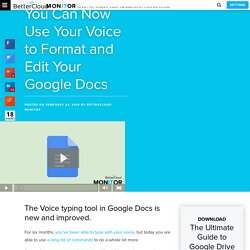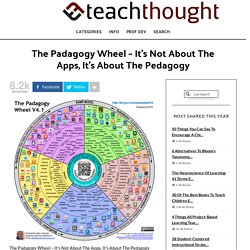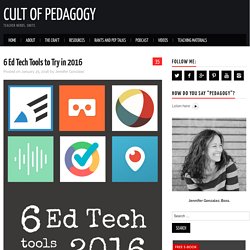

Top tweets today in the EdTech world - top stories by @WickedDecent, @korytellers. The Top Five Legal Issues for Edtech Startups and Schools. Mozgi is a great #k12 research tool: save and catalog texts, images, videos from the web and then share #edtech. Students can use to learn pronunciations of English words with Youngish #k12 #edtech #ESL #ELL. Product Reviews. The Ugly Truth About Teachers Who Don’t Use Tech. Backchannel that you can give attachments to students #ncties16 #k12 #edtech. If you haven't seen this yet, it's great! Discovered it while working w/students as update came in! #EdTech #K12.
For six months, you’ve been able to type with your voice, but today you are able to use a long list of commands to do a whole lot more.

Some of the new commands include adding tables, moving around to different lines of your document, and even formatting your text to align right. To start typing your document with your voice, watch the short video above and follow the steps below. To turn on Voice typing, go to Tools, and then select Voice typing.Next, click on the microphone that appears to the left of your document. When you click it, it will turn red and will begin recording. Click here to watch this video on YouTube. UP NEXT: How to Insert Non-YouTube Videos Into Google Slides. The Big Picture Of Education Technology: The Padagogy Wheel. The Padagogy Wheel – It’s Not About The Apps, It’s About The Pedagogy by Allan Carrington, TeachThought PD Workshop Facilitator *Visit TeachThought Professional Development if you’re interested in our workshop options on the Padagogy Wheel.

The Padagogy Wheel is designed to help educators think – systematically, coherently, and with a view to long term, big-picture outcomes – about how they use mobile apps in their teaching. The Padagogy Wheel is all about mindsets; it’s a way of thinking about digital-age education that meshes together concerns about mobile app features, learning transformation, motivation, cognitive development and long-term learning objectives. The Padagogy Wheel, though, is not rocket science. The underlying principle of the Padagogy Wheel is that it is the pedagogy that should determine our educational use of apps. So how does it work? The Padagogy Wheel brings together in the one chart several different domains of pedagogical thinking. 1. 2. 3. 4. 5. Great Monday morning read: How has Google affected the way students learn? by @MindShiftKQED #EdTech #Education #K12.
Take a look at this question: How do modern novels represent the characteristics of humanity? If you were tasked with answering it, what would your first step be? Would you scribble down your thoughts — or would you Google it? Terry Heick, a former English teacher in Kentucky, had a surprising revelation when his eighth- and ninth-grade students quickly turned to Google. “What they would do is they would start Googling the question, ‘How does a novel represent humanity?’ "6 #EdTech Tools to Try in 2016" from Cult of Pedagogy. About a year ago, I published an e-book called the Teacher’s Guide to Tech.

Over the last month, I have been updating it for 2016, adding over 30 new tools and refreshing the information I had about the original ones. I have to say, the 2015 version was excellent, but now it’s SO MUCH BETTER. (To take a peek at the guide, scroll to the bottom of this post.) In the process, I discovered some tools that I absolutely fell in love with, and I wanted to share them with you here. Each of these tools can make your teaching more efficient and effective, and your students’ learning deeper and more engaging. Let’s take a look. Listen to this post as a podcast: Podcast: Play in new window | Download (Duration: 34:24 — 47.6MB) Subscribe: iTunes | Android | One key to improving student writing is to have students write more often. The free option allows for 40 students and a limited number of posts; paid packages offer greater capacity for students and posts. Here’s a closer look at Write About: